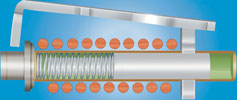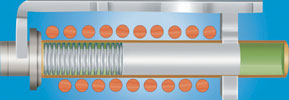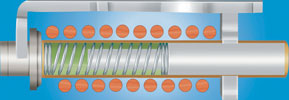
Circuit breaker technologies.
Each component of an electrical installation is designed for use at a particular rated current. When the component is used within the designed current limit it will have a specific service life expectancy, which is the length of time for which the insulation will remain operationally safe.
When a component is overloaded, the temperature in the insulation exceeds the design limit, the insulation begins to deteriorate and the service life will be reduced. Quantitatively, this deterioration depends on both the temperature rise and time for which the insulation is exposed to the overload. Precautions should be taken to avoid, or at least reduce to a minimum, overloading of electrical components. An overload condition can be detected by monitoring the current flowing into an item of equipment and the time for which it flows.
The method of overload sensing incorporated into circuit breakers is usually achieved through one of three different technologies:
* Solid-state electronic sensing.
* Thermal-magnetic sensing.
* Hydraulic-magnetic sensing.

Solid state electronic sensing
This technology is often combined with microprocessor controllers and is generally restricted to larger frame circuit breakers due to cost considerations.

Thermal sensing
This is the oldest technology and has been used since the first appearance of miniature and moulded case circuit breakers. Thermal sensing components such as bimetals, are supported by instantaneously operated magnetic trips for short circuit protection.

Hydraulic-magnetic sensing
This technology is widely used in South Africa and eliminates the inconvenience of early tripping of thermally operated circuit breakers at elevated ambient temperatures. Hydraulic-magnetic circuit breakers have the advantage of more accurate calibration of tripping curves and make possible a variety of tripping curves to suit application-specific requirements including fractional ampere ratings.
Hydraulic-magnetic circuit breakers operate on the principle of the opposing forces of a spring and a viscous fluid controlling the magnetic attraction on a ferrous piston inside a non-magnetic cylinder. The design has both a time delay operation (overload trip) and an instantaneous operation in the case of a short circuit.

When an overcurrent occurs, the magnetic force produced in the coil overcomes the core spring and the core moves towards the pole piece. The closer the core gets to the pole piece, the more magnetised the pole piece becomes. This attracts the armature, which in turn actuates the trip bar. The viscosity of the fluid and the characteristics of the spring govern the time delay. If the overcurrent is excessive, the magnetic field is such that the armature is immediately attracted to the pole piece without the influence of the core.
For more information contact CBI-electric: low voltage, +27 (0)11 928 2000, [email protected], www.cbi-electric.com

© Technews Publishing (Pty) Ltd | All Rights Reserved